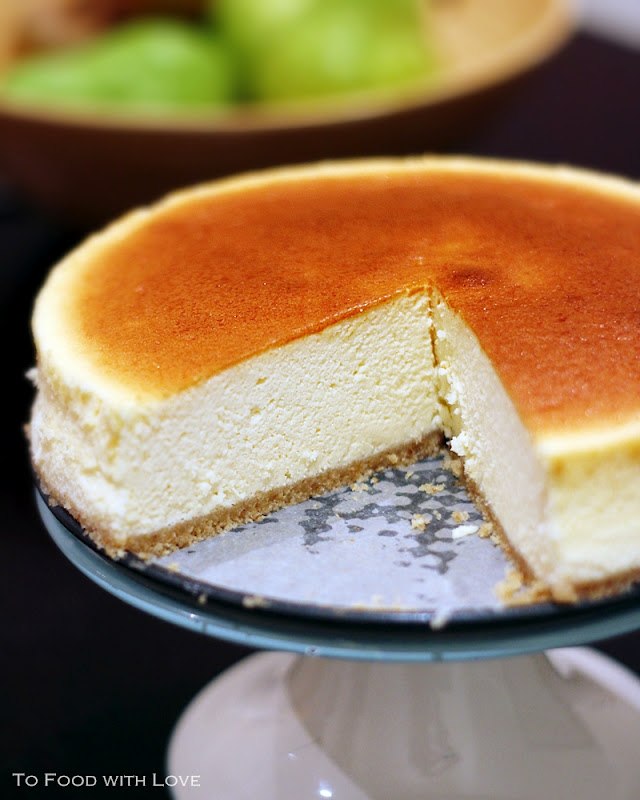Light and Creamy Japanese Cheesecake
My family and I enjoy eating Japanese cheesecake and I have made it a number of times in the past. This time, however, I wanted to make a cheesecake that was not only light and fluffy, but creamy as well and not so cake-like in texture. The typical recipe for Japanese cheesecake uses milk and flour in addition to other ingredients like cream cheese and eggs. In making this creamy version, I've substituted the milk with sour cream and omitted the flour component. I did add a scant amount of cornflour as I figured it might help bind the ingredients (that's what I think anyway) and prevent cracks from forming on top of the cake while it's baking. Whether it helped or not, I can't say for certain, but my cake came out perfect with no cracks at all. It rose nicely in the oven, and didn't collapse in the middle while it was cooling down. In fact, the top of the cake came down slowly until it was just level.
If you must know, I was keeping a watchful eye over the cake from the time it was baking until it cooled down. As with most cheesecakes, it is important to ensure that the cake does not experience any sudden drop in temperature after it's baked, which is why they are usually left to cool in the oven. I think the Cheesecake-gods must have been kind to me that day because not only did my cake not crack, but it shrank ever so slightly that it the top became nice, flat and level (as if I'm not reiterating enough). Because of my constant "watchful eye" over the cake, I managed to catch it just as it was starting to pull off the sides of the pan. So I quickly took it out from the oven and loosened the edges of the cake so as to prevent any cracks from forming while it continued to cool down in the oven. And one more thing: I placed a pan of hot water at the bottom of the oven while baking because apparently the steam that is created also helps to reduce the chance of cracks forming over the cake.
The kids absolutely loved this cake because of its light, fluffy and melt-in-your-mouth texture. Don't expect it to be smooth and creamy like NY style cheesecakes though, because this one is made with a meringue base, and so it has an "airy" meringue-like texture, but creamy nonetheless. And delicious!
Light and Creamy CheesecakeIngredients
Crust:
3/4 cup (about 100g) finely crushed Digestive biscuits (or other sweet biscuits)3 tbsp (50g) butter, melted
Filling:
250g (8oz) Philadelphia cream cheese, at room temperature
2 tbsp fresh milk
1 cup
1/2 cup + 3 tbsp caster sugar
1/2 tbsp lemon juice
3 egg yolks
1 tsp vanilla extract
2 tsp cornflour / cornstarch
3 egg whites
Method
- Preheat oven to 160°C (325°F). Grease and line the base of a 20cm (8 inch) non-stick springform cake tin with non-stick baking paper. Prepare another pan (either roasting tin/cake tin etc is fine) with some boiling water (about 1 inch deep) which you will need to put in the oven later together with the cake. This provides moisture in the oven when the cake is baking and help prevent cracks from forming on top of the cake.
- In a small bowl, mix the ingredients for the crust with a spoon until evenly combined. Press the mixture firmly into the base of the prepared cake tin.
- Using an electric mixer, beat cheese with milk on medium speed until smooth. Beat in the sour cream, 1/2 cup sugar, lemon juice, yolks and vanilla extract until well combined. Beat in the cornflour.
- In another bowl, whisk egg whites to soft peaks, and then add the remaining 3 tbsp sugar. Continue to whisk until they just reach stiff peaks. Gently fold the egg white mixture into the cheese mixture above until well combined.
- Pour into the cake tin over the crust. Place the pan of boiling water (step 1 above) in the lowest rack of the oven. Place the cake on the middle rack, and bake for 50 minutes or until lightly golden brown. The top of the cake will still have a slight wobble when you move the tin. Turn off the oven. Let the cake sit in the oven for 1 hour with the oven door closed. After that, you can leave the door ajar with a one-inch gap and let the cake cool for another 2-3 hours. You can leave the door closed too if you want (it will just take longer to cool!). While the cake is cooling, the top of the cake may start to come down slowly. That's fine. The top of the cake will be flat and level, and shouldn't collapse if you let it slowly cool down in the oven.
- While the cake is cooling, the sides will start to shrink and come off the side of the cake tin. At this point, you can remove the cake from the oven and run a sharp knife around the edge of the tin. Quickly put the cake back in the oven and close the oven door (or leave it 1 inch ajar).
- Once the cake has completely cooled (if it's just a little warm, it's okay too), remove from the oven and refrigerate for 4-6 hours.
- Remove the cheesecake from the pan. Cut into slices with a hot sharp knife. Dust with icing sugar and serve with strawberries and cream if desired.
 |
| Nicely browned with no cracks on top |







Comments
Post a Comment